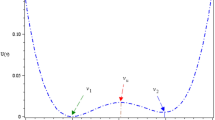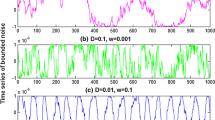Abstract
The aim of this paper is to explore the phenomenon of aperiodic stochastic resonance in neural systems with colored noise. For nonlinear dynamical systems driven by Gaussian colored noise, we prove that the stochastic sample trajectory can converge to the corresponding deterministic trajectory as noise intensity tends to zero in mean square, under global and local Lipschitz conditions, respectively. Then, following forbidden interval theorem we predict the phenomenon of aperiodic stochastic resonance in bistable and excitable neural systems. Two neuron models are further used to verify the theoretical prediction. Moreover, we disclose the phenomenon of aperiodic stochastic resonance induced by correlation time and this finding suggests that adjusting noise correlation might be a biologically more plausible mechanism in neural signal processing.







Similar content being viewed by others
References
Averbeck BB, Latham PE, Pouget A (2006) Neural correlations, population coding and computation. Nat Rev Neurosci 7(5):358–366
Benzi R, Sutera A, Vulpiani A (1981) The mechanism of stochastic resonance. J Phys A 14(11):L453–L457
Capurro A, Pakdaman K, Nomura T, Sato S (1998) Aperiodic stochastic resonance with correlated noise. Phys Rev E 58(4):4820–4827
Collins JJ, Chow CC, Imhoff TT (1995) Aperiodic stochastic resonance in excitable systems. Phys Rev E 52(4):R3321–R3324
Collins JJ, Chow CC, Capela AC, Imhoff TT (1996a) Aperiodic stochastic resonance. Phys Rev E 54(5):5575–5584
Collins JJ, Imhoff TT, Grigg P (1996b) Noise-enhanced information transmission in rat SA1 cutaneous mechanoreceptors via aperiodic stochastic resonance. J Neurophysiol 76(1):642–645
Cover TM, Thomas JA (1991) Elements of information theory. Wiley, New York
Déli E, Tozzi A, Peters JF (2017) Relationships between short and fast brain timescales. Cogn Neurodyn 11(6):539–552
Dylov DV, Fleischer JW (2010) Nonlinear self-filtering of noisy images via dynamical stochastic resonance. Nat Photon 4(5):323–328
Floris C (2015) Mean square stability of a second-order parametric linear system excited by a colored Gaussian noise. J Sound Vib 336:82–95
Freidlin MI, Wentzell AD, Tr. by Szuecs J (2012) Random perturbations of dynamical systems. Springer, Berlin
Fu YX, Kang YM, Chen GR (2020) Stochastic resonance based visual perception using spiking neural networks. Front Comput Neurosci 14:24
Gammaitoni L, Hänggi P, Jung P, Marchesoni F (1998) Stochastic resonance. Rev Mod Phys 70(1):223–287
Gao FY, Kang YM, Chen X, Chen GR (2018) Fractional Gaussian noise enhanced information capacity of a nonlinear neuron model with binary input. Phys Rev E 97(5):052142
Gu HG, Pan BB (2015) Identification of neural firing patterns, frequency and temporal coding mechanisms in individual aortic baroreceptors. Front Comput Neurosci 9:108
Guan LN, Gu HG, Jia YB (2020) Multiple coherence resonances evoked from bursting and the underlying bifurcation mechanism. Nonlinear Dyn 100:3645–3666
Guo DQ (2011) Inhibition of rhythmic spiking by colored noise in neural systems. Cogn Neurodyn 5(3):293–300
Kang YM, Xu JX, **e Y (2005) Signal-to-noise ratio gain of a noisy neuron that transmits subthreshold periodic spike trains. Phys Rev E 72(2):021902
Kim SY, Lim W (2018) Effect of spike-timing-dependent plasticity on stochastic burst synchronization in a scale-free neuronal network. Cogn Neurodyn 12(3):315–342
Kosko B, Lee I, Mitaim S, Patel A, Wilde MM (2009) Applications of forbidden interval theorems in stochastic resonance. In: Applications of Nonlinear Dynamics. Springer, New York
Lee KE, Lopes MA, Mendes JFF, Goltsev AV (2014) Critical phenomena and noise-induced phase transitions in neuronal networks. Phys Rev E 89(1):012701
Levin JE, Miller JP (1996) Broadband neural encoding in the cricket cereal sensory system enhanced by stochastic resonance. Nature 380(6570):165–168
Liu RN, Kang YM (2018) Stochastic resonance in underdamped periodic potential systems with alpha stable Lévy noise. Phys Lett A 382(25):1656–1664
Liu J, Li Z (2015) Binary image enhancement based on aperiodic stochastic resonance. IET Image Process 9(12):1033–1038
Lü Y, Lu H (2019) Anomalous dynamics of inertial systems driven by colored Lévy noise. J Stat Phys 176(4):1046–1056
Mao XR (2007) Stochastic differential equations and applications, 2nd edn. Woodhead Publishing Limited, London
Mao XR, Sababis S (2003) Numerical solutions of stochastic differential delay equations under local Lipschitz condition. J Comput Appl Math 151(1):215–227
Mizraji E, Lin J (2017) The feeling of understanding: an exploration with neural models. Cogn Neurodyn 11(2):135–146
Nakamura O, Tateno K (2019) Random pulse induced synchronization and resonance in uncoupled non-identical neuron models. Cogn Neurodyn 13(3):303–312
Øksendal B (2005) Stochastic differential equations: an introduction with applications, 6th edn. Springer, Berlin
Patel A, Kosko B (2005) Stochastic resonance in noisy spiking retinal and sensory neuron models. Neural Netw 18(5–6):467–478
Patel A, Kosko B (2008) Stochastic resonance in continuous and spiking neuron models with Levy noise. IEEE Trans Neural Netw 19(12):1993–2008
Prato GD, Zabczyk J (1992) Stochastic equations in infinite dimensions. Cambridge University Press, Cambridge
Sakai Y, Funahashi S, Shinomoto S (1999) Temporally correlated inputs to leaky integrate-and-fire models can reproduce spiking statistics of cortical neurons. Neural Netw 12(7–8):1181–1190
Song JL, Paixao L, Li Q, Li SH, Zhang R, Westover MB (2019) A novel neural computational model of generalized periodic discharges in acute hepatic encephalopathy. J Comput Neurosci 47(2–3):109–124
Tiwari I, Phogat R, Parmananda P, Ocampo-Espindola JL, Rivera M (2016) Intrinsic periodic and aperiodic stochastic resonance in an electrochemical cell. Phys Rev E 94(2):022210
Wang HY, Wu YJ (2016) First-passage problem of a class of internally resonant quasi-integrable Hamiltonian system under wide-band stochastic excitations. Int J Nonlin Mech 85:143–151
Wang RB, Wang GZ, Zheng JC (2014) An exploration of the range of noise intensity that affects the membrane potential of neurons. Abstr Appl Anal 2014:801642
Xu Y, Guo YY, Ren GD, Ma J (2020) Dynamics and stochastic resonance in a thermosensitive neuron. Appl Math Comput 385(15):125427
Yan CK, Wang RB, Pan XC (2013) A model of hippocampal memory based on an adaptive learning rule of synapses. J Biol Syst 21(03):1350016
Yang T (1998) Adaptively optimizing stochastic resonance in visual system. Phys Lett A 245:79–86
Zeng FG, Fu QJ, Morse R (2000) Human hearing enhanced by noise. Brain Res 869:251–255
Zhao J, Qin YM, Che YQ, Ran HYQ, Li JW (2020) Effects of network topologies on stochastic resonance in feedforward neural network. Cogn Neurodyn 14:399–409
Acknowledgements
This work is financially supported by the National Natural Science Foundation of China (Grant No. 11772241).
Author information
Authors and Affiliations
Corresponding author
Additional information
Publisher's Note
Springer Nature remains neutral with regard to jurisdictional claims in published maps and institutional affiliations.
Appendix
Appendix
Proof of Lemma 1
Proof
Fix \(T \ge 0\) arbitrarily. The Ito formula (Øksendal 2005; Mao 2007) shows that
for \(0 \le t \le T\). By the moment property (3) of the stationary OU process, we get
By the Burkholder–Davis–Gundy inequality (Prato and Zabczyk 1992),
Using the Hölder inequality we then derive
□
Proof of Lemma 2
Proof
It is well known that almost all sample paths of the Ornstein–Ulenbeck process are continuous. It is therefore easy to see from the classical theory of ordinary differential equations that for any initial value \(X_{0} \in R^{d}\), Eq. (1) has a unique global solution \(X_{t}\) on \(t \ge 0\). Fix \(T \ge 0\) arbitrarily. According to Lemma 1,
with \(\xi_{k}\) given by Eq. (7).
Define the stop** times \(\tau_{h} = \inf \{ t \ge 0:\left| {X_{t} } \right| \ge h\}\) for all integers \(h > \left| {X_{0} } \right|\), where throughout this paper we set \(\inf \varPhi = \infty\). Here \(\varPhi\) stands for the empty set. Clearly, \(\tau_{h} \to \infty\) almost surely as \(h \to \infty\). For \(t \in \left[ {0,T} \right]\), it follows from Eq. (1a) that
Here, the first inequality is due to \((a_{1} + \cdots + a_{m} )^{p} \le m^{p - 1} (\left| {a_{1} } \right|^{p} + \cdots + \left| {a_{m} } \right|^{p} )\), the second inequality is owing to the Hölder inequality; the growth conditions are adopted for the last second equality; and the inequality \((\left| a \right| + \left| b \right| )^{p} \le 2^{p - 1} (\left| a \right|^{p} + \left| b \right|^{p} )\) is used in the last inequality. As the right-hand-side terms are increasing in \(t\), we see easily that
and then by \(\left| {X_{ 0}^{i} } \right|^{p} = \left( {\left| {X_{ 0}^{i} } \right|^{ 2} } \right)^{{\frac{p}{2}}} \le \left( {\sum\limits_{i = 1}^{d} {\left| {X_{ 0}^{i} } \right|^{ 2} } } \right)^{{\frac{p}{2}}} = \left| {X_{0} } \right|^{p} ,\)
By the well-known Young inequality \(xy \le \frac{{x^{p} }}{p} + \frac{{y^{q} }}{q}\) for \(x,y \ge 0\) and \(p,q > 0\) with \(\frac{1}{p} + \frac{1}{q} = 1\),
while recalling that \(\bar{k} \ge \frac{p}{2(1 - \gamma )}\) in Eq. (13), then by the Hölder inequality,
Hence, by Eq. (30),
Considering
then
Here, the distribution property for the maximum of multiple mutually independent random variables is adopted. Then for any \(0 \le t \le T\),
with \(a_{p}\) and \(b_{p}\) given in Eqs. (11) and (12). And then, the application of the Gronwall inequality to Eq. (31) yields
Letting \(h \to \infty\) implies the required assertion (10). □
Proof of Lemma 3
Proof
Note the inequality (15) can be proven with technique somehow parallel to that of Lemma 2. It is well known that under given conditions Eq. (3) has a unique global solution \(\hat{X}_{t}\) on \(t \ge 0\). Define a sequence \(v_{h} = \inf \{ t \ge 0:\left| {\hat{X}_{t} } \right| \ge h\}\) for all integers \(h \ge \left| {X_{0} } \right|\), with \(\inf \varPhi = \infty\) for an empty set \(\varPhi\). Clearly, \(v_{h} \to \infty\) almost surely as \(h \to \infty\). For \(t \in \left[ {0,T} \right]\), it can be deduced from (3) that for \(0 < t < T\),
Then, the Gronwall inequality implies
Letting \(h \to \infty\) implies the assertion (15) immediately. □
Proof of Lemma 4
Proof
Recalling the duplicate property of the conditional probability distribution
we obtain
from which it can be deduced that
and thus by Theorem 2, Eq. (25) is found true. Then, application of Markov’s inequality immediately gives Eq. (26). □
Rights and permissions
About this article
Cite this article
Kang, Y., Liu, R. & Mao, X. Aperiodic stochastic resonance in neural information processing with Gaussian colored noise. Cogn Neurodyn 15, 517–532 (2021). https://doi.org/10.1007/s11571-020-09632-3
Received:
Revised:
Accepted:
Published:
Issue Date:
DOI: https://doi.org/10.1007/s11571-020-09632-3




